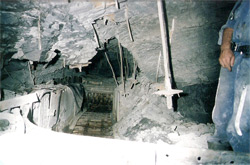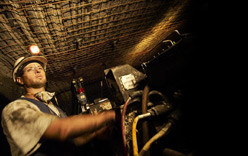AVOIDING AND CORRECTING PROBLEMS
d) CORRECTION
Roof Failure
Even though roof movement has reached the point where failure is beginning to occur, the option of continuous production may still be effective if
the face can be advanced fast enough to enable the "lip" on the face side of the failed section to be "caught" by the advancing supports before
it falls, the failure thus prevented from advancing with the face. This action entails a risk that the lip cannot be caught and the roof failure becomes more extensive.
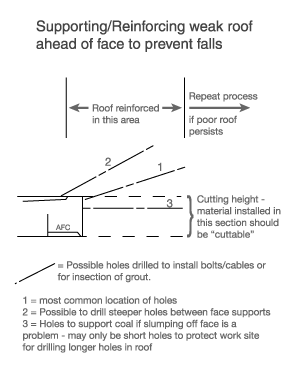 If the above option is considered too risky, the next option in degree of complexity is to install roof reinforcement along the
face with some form of roof bolting, using solid roof bolts or some form of flexible cable bolt, usually angled ahead of the face over
the next one or more shears. The bolts are usually installed with hand held
bolting rigs or rigs attached to the AFC. Additional local support of the roof and/or face coal may be required to be installed in order
to provide a safe work area for installation of the main reinforcement. Care is required with whatever is installed that, if possible, any
portion which remains within the part of the seam to be cut consists of "cuttable" material e.g. timber or plastic, rather than steel. Steel
can be dealt with if necessary, but can cause problems to equipment or may need to be cut manually with the additional
risk of having to work adjacent to the freshly mined area.
If the above option is considered too risky, the next option in degree of complexity is to install roof reinforcement along the
face with some form of roof bolting, using solid roof bolts or some form of flexible cable bolt, usually angled ahead of the face over
the next one or more shears. The bolts are usually installed with hand held
bolting rigs or rigs attached to the AFC. Additional local support of the roof and/or face coal may be required to be installed in order
to provide a safe work area for installation of the main reinforcement. Care is required with whatever is installed that, if possible, any
portion which remains within the part of the seam to be cut consists of "cuttable" material e.g. timber or plastic, rather than steel. Steel
can be dealt with if necessary, but can cause problems to equipment or may need to be cut manually with the additional
risk of having to work adjacent to the freshly mined area.
It is becoming increasingly common, rather than installing bolts or cables, to use some type of grout pumped into boreholes, usually under sufficient pressure so that some material is forced into joints or cracks in the strata to "glue" it all together. This has the advantage of being able to spread the effect through a greater volume of strata than bolts can affect, and all material being cuttable. The disadvantages are:
- it usually takes longer to set-up the equipment for this work,
- some materials (e.g. polyurethane, usually referred to as PUR) are quite strongly exothermic, entailing a fire risk if used in large quantities,
- some materials (also PUR) contain material which can be injurious to health if inhaled as a fine spray in the pre-mixed state and therefore require special precautions if used, and
- there is some risk of the pumping and material expansion process itself pressurising the strata and causing further failure.
It is not necessary, or even normal, to progress through the different options on a trial and error basis for handling failed roof but
operations may stop and major reinforcement begin immediately, or even before roof failure actually occurs if a potential problem area has been identified in advance.
Frequently there will be a Strata Management Plan in place which will specify actions to be taken for different degrees of roof failure or signs of potential failure.
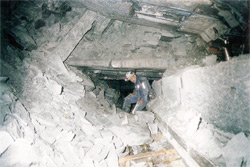
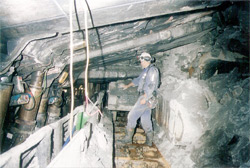
If precautions or actions noted above have not been taken or have not been successful then a major roof fall may occur, possibly leaving a large cavity when fallen material is removed or with more material continuing to fall if the initial fallen material is removed. In either case it will be necessary to stop operations and stabilise the fallen area in order to be able to advance further.
In the case of an empty cavity it may be possible simply to gain access above the supports and place timber chocks between the support canopies and roof to allow advance to continue. In this case support of the cavity roof is minimal and the main function of the timber is to provide material for the hydraulic face supports to bear against, sufficiently stable to resist the reaction force from adjacent supports or the AFC being moved forward. While this process is simple and relatively cheap, there is a strong possibility that the cavity will continue to extend as the face advances. Placing timber above the supports can be a hazardous exercise, possibly entailing too great a risk for it to be viable.
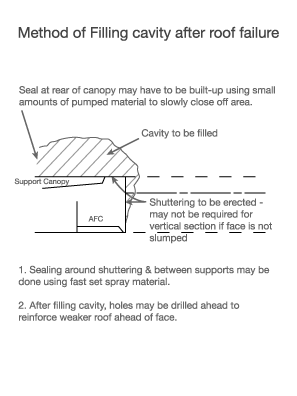 It is more common now for grouts to be used to fill cavities (providing support to all surfaces of the cavity as well as providing material for supports to bear against) or
to be injected into loose fall material so that it becomes sufficiently consolidated to act as replacement roof strata and allow production to continue. In either case there
is usually considerable work involved in constructing formwork around the area to be grouted, sometimes requiring manual excavation of sections of coal or stone to allow
formwork to be installed and sealed. PUR is seldom used for this type of grouting, because of its exothermic properties and cost (often large volumes are required), and
lightweight concrete is a frequent option, being cheap and relatively easy to handle. A high strength material is not required, the main purpose being confinement of strata
still in place and providing a false roof for the supports to work against.
It is more common now for grouts to be used to fill cavities (providing support to all surfaces of the cavity as well as providing material for supports to bear against) or
to be injected into loose fall material so that it becomes sufficiently consolidated to act as replacement roof strata and allow production to continue. In either case there
is usually considerable work involved in constructing formwork around the area to be grouted, sometimes requiring manual excavation of sections of coal or stone to allow
formwork to be installed and sealed. PUR is seldom used for this type of grouting, because of its exothermic properties and cost (often large volumes are required), and
lightweight concrete is a frequent option, being cheap and relatively easy to handle. A high strength material is not required, the main purpose being confinement of strata
still in place and providing a false roof for the supports to work against.
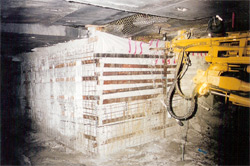 Whatever material is used, any that is mined with the coal will report to the coal preparation plant and can have deleterious effects on fluid density in the plant and possibly on pumps or pipelines. Any possible effects should be considered before use and if considered desirable it may be possible to remove this material from the coal stream and discard it before it reaches the preparation plant.
Whatever material is used, any that is mined with the coal will report to the coal preparation plant and can have deleterious effects on fluid density in the plant and possibly on pumps or pipelines. Any possible effects should be considered before use and if considered desirable it may be possible to remove this material from the coal stream and discard it before it reaches the preparation plant.
Such treatment of a major fall will entail the face standing for some time which could result in excessive closure before the fall work is completed. Additional roof reinforcement may be required elsewhere along the face or in the gate roads in conjunction with the fall correction to avoid such problems. In the worst case the face could become iron bound requiring manual excavation to allow supports to be moved again and/or additional falls may occur.
Roof failures in the gate roads have been dealt with in the Longwall section of the Fundamentals of Coal Mining module and those comments are not repeated here.
